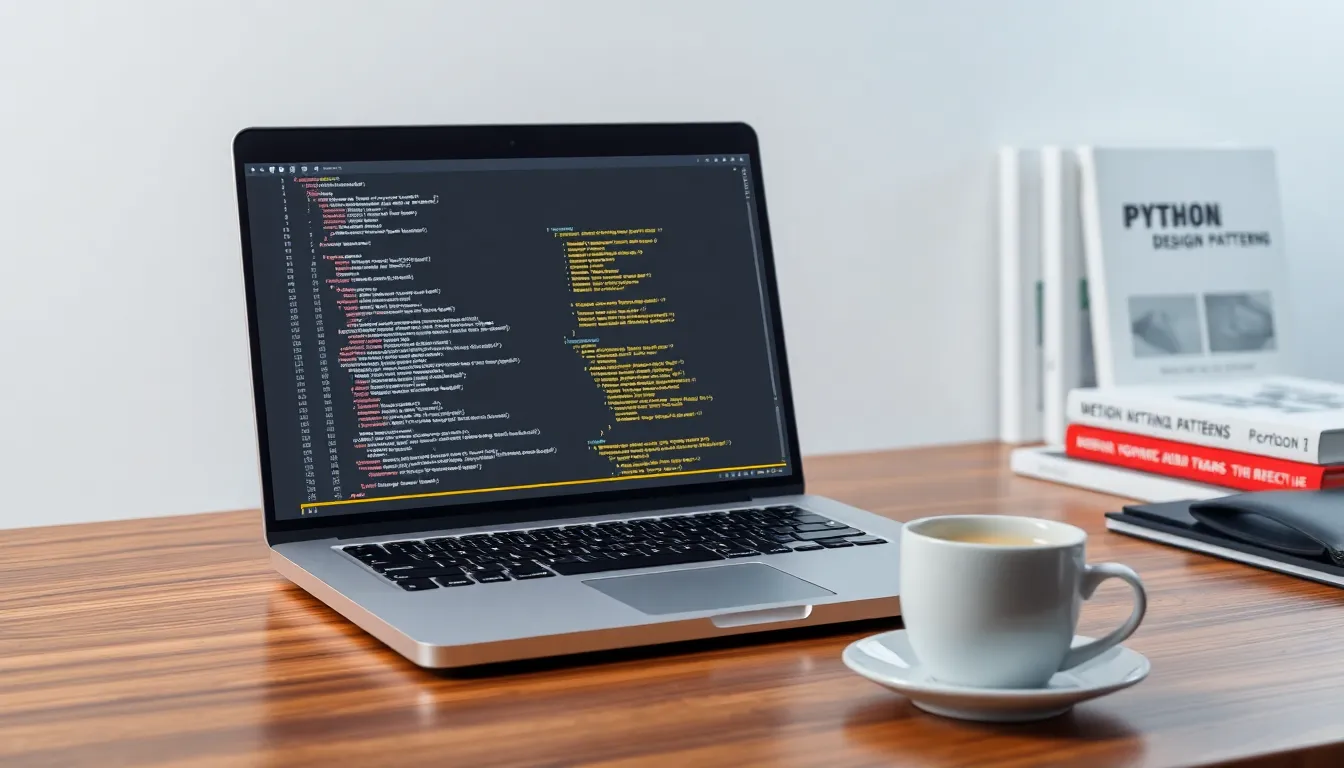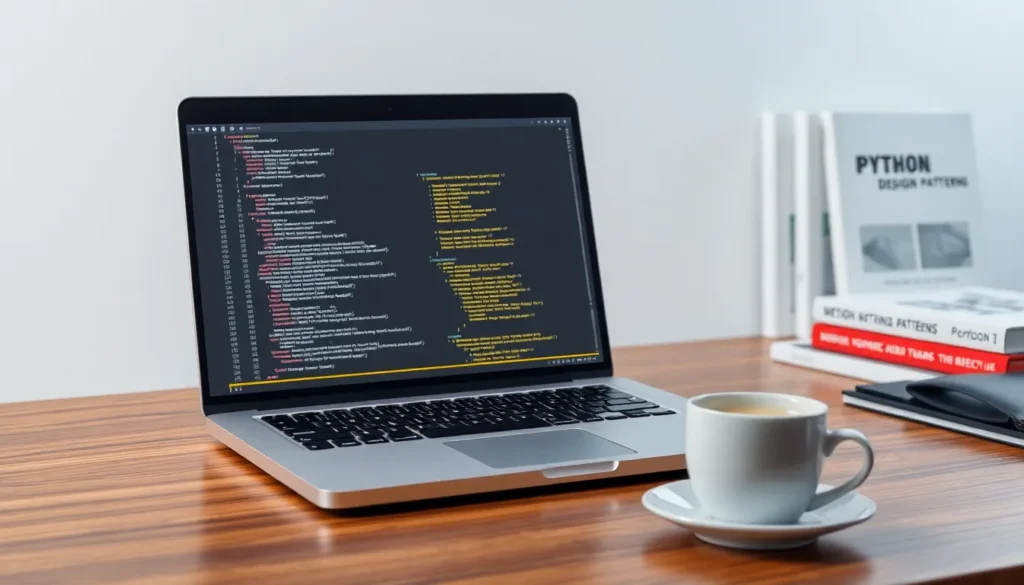Python design patterns are like the secret sauce that makes programming not just functional but also a whole lot more enjoyable. Imagine trying to bake a cake without a recipe—sure, you might end up with something edible, but it likely won’t win any awards. Design patterns provide tried-and-true solutions to common coding problems, helping developers whip up elegant, maintainable code without breaking a sweat.
Table of Contents
ToggleOverview of Python Design Patterns
Python design patterns offer robust solutions to common programming challenges. These patterns serve as templates, streamlining development processes and fostering code reusability. Categories of design patterns include creational, structural, and behavioral patterns, each addressing distinct aspects of software design.
Creational patterns focus on object creation mechanisms, promoting flexibility and efficiency. Examples include the Singleton pattern, which restricts instantiation to a single instance, and the Factory Method pattern, which delegates object creation to subclasses.
Structural patterns deal with object composition, emphasizing relationships between entities. The Adapter pattern illustrates how to enable incompatible interfaces to work together, while the Composite pattern allows individuals and composites to be treated uniformly.
Behavioral patterns concentrate on communication between objects. The Observer pattern exemplifies how objects can maintain a dependability on changes in other objects, while the Strategy pattern facilitates choosing algorithms or behaviors at runtime.
Utilizing these patterns enhances the clarity and maintainability of code. Developers grasp the intent behind code constructs more easily when they employ established patterns. Additionally, design patterns not only simplify problem-solving but also improve collaboration among team members by providing a common vocabulary and understanding.
Adopting Python design patterns contributes significantly to crafting high-quality applications. The disciplined approach encourages transparency, leading to fewer bugs and smoother integration of new functionalities over time. By familiarizing oneself with these patterns, programmers elevate the quality and efficiency of their codebases.
Creational Patterns

Creational patterns deal with object creation mechanisms. These patterns simplify the instantiation process while enhancing code flexibility and reusability.
Singleton Pattern
The Singleton pattern restricts the instantiation of a class to one instance. This design pattern provides a global access point to that instance. Developers often use it to manage shared resources, like database connections. When multiple threads access the same resource, the Singleton pattern ensures consistent resource management. In Python, implementing the Singleton pattern commonly involves using a class variable to hold the instance. This approach guarantees that any subsequent calls return the same instance, preserving memory and improving performance.
Factory Method Pattern
The Factory Method pattern defines an interface for creating objects but lets subclasses alter the type of created objects. This flexibility allows developers to introduce new product types without changing existing code. By encapsulating object creation, the Factory Method enhances code scalability and maintenance. Python’s approach commonly involves defining a method in a base class and overriding it in derived classes. This structure promotes adherence to the Open/Closed Principle, allowing systems to remain open for extension but closed for modification. Implementing the Factory Method pattern streamlines code and fosters more intuitive interactions among object creators and products.
Structural Patterns
Structural patterns focus on how objects and classes interact in Python applications. They help define relationships and facilitate easier collaboration between components.
Adapter Pattern
The Adapter pattern allows incompatible interfaces to work together. By wrapping a class with an interface adapted for client use, this pattern enhances flexibility in code. For instance, when integrating third-party libraries, an Adapter can convert their APIs to match application requirements. This approach reduces the need for extensive modifications and promotes compatibility. Developers enjoy easier transitions between different systems, enhancing the overall architecture. Adapting to new requirements becomes simpler as a result, preserving existing functionality while introducing new features. Code readability improves, enabling streamlined testing and maintenance over time.
Composite Pattern
The Composite pattern simplifies the treatment of individual objects and compositions uniformly. It allows developers to build complex tree structures while treating single objects and groups of objects the same way. By creating a common interface for leaves and composites, the pattern promotes easier management of hierarchies. For example, a graphical application might use this pattern to represent shapes, where both individual shapes and groups of shapes can be manipulated interchangeably. This uniformity enhances scalability and flexibility in code functionality. Understanding the relationships between components improves, which leads to clearer design and reduced complexity in managing hierarchies.
Behavioral Patterns
Behavioral patterns focus on how objects communicate and interact within a system. These patterns enhance program flexibility and promote clean systems architecture.
Observer Pattern
The Observer pattern establishes a one-to-many relationship between objects. When a subject’s state changes, all dependent observers receive automatic updates. This setup maintains synchronization between components efficiently. Developers often use this pattern in applications requiring real-time updates, such as stock ticker systems. The pull model is typically implemented, where observers request data from the subject as needed. Furthermore, this pattern promotes loose coupling, allowing for dynamic additions or removals of observers without altering the subject. As a result, an Observer pattern implementation enhances scalability and responsiveness in applications.
Strategy Pattern
The Strategy pattern enables the selection of algorithms at runtime. This pattern defines a family of interchangeable algorithms, encapsulating each one so they can be swapped easily. By using this pattern, developers can avoid conditional statements scattered throughout the codebase, resulting in cleaner code. The client program maintains a reference to a strategy interface, allowing for runtime selection based on context or user preferences. Implementing the Strategy pattern fosters greater flexibility, as new strategies can be introduced without modifying existing code. Hence, this pattern encourages the adherence to the Open/Closed Principle, facilitating easier future enhancements.
Advantages of Using Design Patterns in Python
Utilizing design patterns in Python presents numerous advantages that enhance software development. Code maintainability supersedes other concerns; it becomes easier to update and modify when design patterns are in place. Clarity in code structure improves, allowing developers to quickly understand and navigate through complex systems.
Reusability plays a critical role in design patterns. By following established patterns, programmers can create components that integrate effortlessly into future projects. Collaboration benefits as well; team members share a common vocabulary, improving communication around design strategies.
Flexibility becomes evident with behavioral patterns. These patterns enable changes to be made without extensive code rewrites, streamlining the development process. Scalability sees an increase since patterns like the Factory Method support growth by adapting to changing requirements.
Efficiency in debugging also improves. Design patterns promote consistency, reducing errors introduced by variations in coding practices. Additionally, leveraging patterns encourages adherence to best practices, fostering a culture of quality within teams.
Lastly, performance optimization is attainable through careful pattern selection. By applying suitable patterns, developers can enhance application performance while ensuring resource management remains efficient. Overall, employing design patterns in Python leads to a more elegant and effective approach to software development.
Embracing Python design patterns transforms the coding landscape for developers. By leveraging these established solutions, programmers can craft code that’s not only functional but also elegant and maintainable. This approach fosters collaboration and enhances communication within teams, paving the way for more efficient development processes.
With a solid grasp of creational, structural, and behavioral patterns, developers can tackle various programming challenges effectively. The flexibility and scalability offered by these patterns empower them to adapt to evolving project requirements with ease. Ultimately, incorporating design patterns into Python projects leads to high-quality applications that stand the test of time, ensuring smoother integration of new features and improvements.










